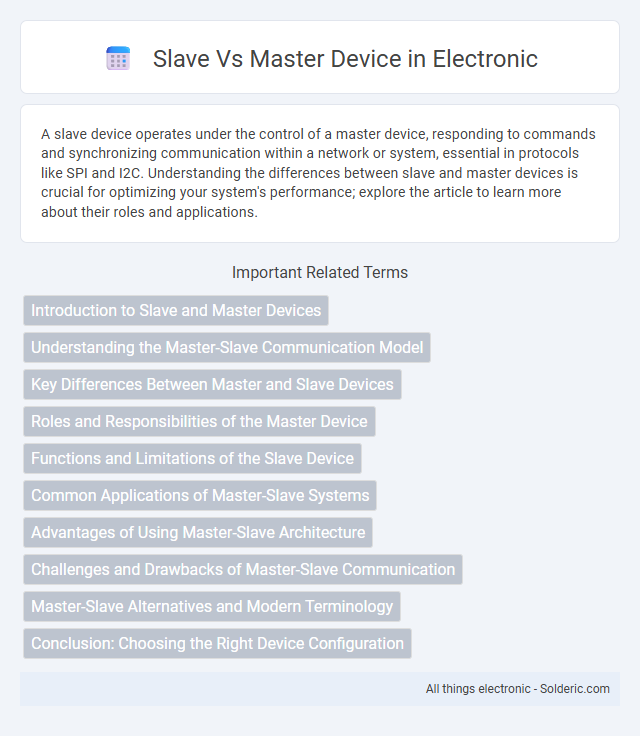A slave device operates under the control of a master device, responding to commands and synchronizing communication within a network or system, essential in protocols like SPI and I2C. Understanding the differences between slave and master devices is crucial for optimizing your system's performance; explore the article to learn more about their roles and applications.
Comparison Table
| Aspect | Slave Device | Master Device |
|---|---|---|
| Role | Responds to commands, executes tasks as directed | Controls communication, initiates commands |
| Communication Initiation | Passive, waits for requests | Active, starts data exchange |
| Control | Receives control signals | Sends control signals |
| Data Transmission | Transmits data upon request | Requests and collects data |
| Examples | Peripheral sensors, slave microcontrollers | Central processor, master microcontrollers |
| Use Cases | Data acquisition, peripheral control | System coordination, communication management |
Introduction to Slave and Master Devices
Master and slave devices are fundamental components in communication protocols, where the master controls the flow of data, and the slave responds to the master's commands. In systems like SPI or I2C, the master initiates and manages communication, while the slave remains passive until addressed. Understanding the roles of these devices is crucial for optimizing data exchange and ensuring efficient synchronization in your network.
Understanding the Master-Slave Communication Model
The Master-Slave communication model establishes a hierarchical relationship where the master device controls the communication flow, initiating commands and managing data exchange with slave devices. Slave devices respond to the master's requests, performing tasks or providing data as instructed, ensuring synchronized and orderly communication. This model is widely implemented in protocols like Modbus, I2C, and SPI, optimizing device coordination in industrial automation and embedded systems.
Key Differences Between Master and Slave Devices
Master devices control communication by initiating commands and managing data flow, while slave devices respond to the master's requests without initiating actions. Master devices often have processing capabilities to coordinate multiple slaves, whereas slave devices are typically simpler, performing assigned tasks as directed. The distinction affects network roles, data exchange hierarchy, and overall system design in protocols like I2C and Modbus.
Roles and Responsibilities of the Master Device
The master device controls communication timing and initiates data transfer in a network, managing synchronization among slave devices. It assigns tasks, monitors responses, and ensures data integrity by coordinating message exchanges. The master device also handles error detection and recovery, maintaining overall system stability.
Functions and Limitations of the Slave Device
The slave device functions by responding to commands from the master device, executing tasks such as data reception, transmission, and synchronization within communication protocols like I2C and SPI. Its limitations include an inability to initiate communication, dependence on the master for clock signals, and restricted control over data flow, which can impact timing and efficiency. Your system's performance relies heavily on understanding these constraints to optimize the master-slave interaction effectively.
Common Applications of Master-Slave Systems
Master-slave systems are widely used in industrial automation, robotics, and communication networks to coordinate device operations efficiently. In programmable logic controllers (PLCs), the master device controls multiple slave units to manage input/output signals and ensure synchronized processes. Data acquisition systems also employ master-slave configurations to centralize control and streamline sensor data collection for monitoring and analysis.
Advantages of Using Master-Slave Architecture
Master-Slave architecture offers centralized control, enhancing system reliability and simplifying communication protocols among devices. The master device coordinates tasks, reducing conflicts and ensuring synchronized operations, which increases overall efficiency. With this setup, your network benefits from easier troubleshooting and scalability, improving performance in industrial and data communication applications.
Challenges and Drawbacks of Master-Slave Communication
Master-slave communication faces challenges such as single points of failure, where the master device's malfunction halts the entire system, causing significant downtime. This architecture limits scalability and flexibility, since slaves cannot initiate communication or operate independently, restricting your network's responsiveness and fault tolerance. Latency issues also arise due to the master's constant polling of slaves, which can degrade performance in time-sensitive applications.
Master-Slave Alternatives and Modern Terminology
The traditional Master-Slave terminology has evolved into more inclusive alternatives such as Primary-Secondary, Leader-Follower, or Controller-Peripheral to better reflect collaborative roles in device communication. These modern terms emphasize mutual functionality and eliminate hierarchical implications, enhancing clarity in system design and documentation. By adopting this updated language, your technical communication aligns with current industry standards and promotes respectful, precise descriptions of device relationships.
Conclusion: Choosing the Right Device Configuration
Choosing the right device configuration between Slave and Master depends on your specific communication needs and system architecture. Master devices control data flow and initiate communication, while Slave devices respond to requests, making the Master-Slave setup ideal for hierarchical systems requiring centralized control. Your decision should prioritize factors like scalability, control requirements, and complexity to ensure optimal network performance.
Slave vs Master device Infographic

 solderic.com
solderic.com